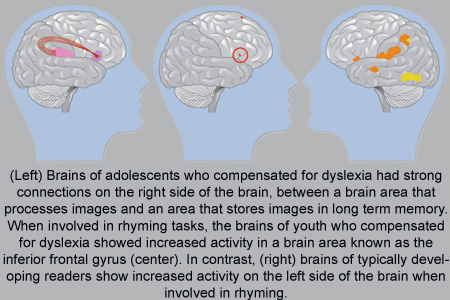
Brain scans seem to foretell the capability of an individual to compensate for dyslexic. According to a recent study, brain scans of dyslexic adolescents show the ability to compensate for their dyslexia through a distinct pattern of brain activity. It was suggested that imaging or other measures of brain activity can identify dyslexics who most readily benefit from various specific interventions.
Throughout the investigation, experts employed two types of brain imaging technology, fMRI and diffusion tensor magnetic resonance imaging, (DTI). While fMRI is known to depict oxygen use by brain areas involved in a particular task or activity, DTI maps the brain’s wiring, revealing connections between brain areas. During the study, adolescents had to view pairs of printed words and identify pairs that rhymed. Those who would later compensate for their dyslexia apparently displayed a pattern of heightened activity in the brain region termed as inferior frontal gyrus. This area presumably regulates the ability to halt an ongoing activity.
DTI scans of the brain also note stronger connections in the superior longitudinal fasiculus, which is a network of neural fibers linking the front and rear of brain. These fibers are apparently involved in the processing of visual aspects of text. Scientists are unable to gauge the way inferior frontal gyrus and superior longitudinal fasiculus are included in compensating for dyslexia. At the time of the study, 45 adolescents aged between 11 to 14 years were made to undergo a battery of tests for ascertaining reading abilities. The series of tests were initiated to calculate phonemic awareness that is the ability to distinguish between the sounds that make up spoken words.
Alan E. Guttmacher, M.D., director of the NIH’s Eunice Kennedy Shriver National Institute of Child Health and Human Development, commented, “This finding provides insight into how certain individuals with dyslexia may compensate for reading difficulties. Understanding the brain activity associated with compensation may lead to ways to help individuals with this capacity draw upon their strengths. Similarly, learning why other individuals have difficulty compensating may lead to new treatments to help them overcome reading disability.”
Experts also measured how well they could comprehend what they read, how fluently and accurately they could read, how fast they could read, spelling ability, the ability to rapidly name objects, letters, numbers and colors, and the size of their vocabularies. 25 adolescents were classified as having dyslexia on the basis of their scores in these tests. Those distinguished as dyslexic seemingly had complications in learning to read despite adequate teaching and exposure to written language. Along with adapted computer algorithms employed in artificial intelligence research, authors accumulated data by the scanner, to estimate subtle brain functioning and structure with a high degree of accuracy. As per the fMRI scans of adolescents without dyslexia demonstrating normal reading ability had strong brain activation patterns on the left side of the brain when performing the rhyming task.
Brain scans of the dyslexic adolescents, on the other hand, seemingly revealed weak activation on the left side of the brain. 13 dyslexic adolescents who later were able to compensate for their disability may have pointed out strong activation in the right inferior frontal gyrus. DTI scans for the compensating group allegedly highlighted a strong network of connections in the superior longitudinal fasiculus on the right side of the brain. On administering the reading test battery, it appeared that two and one half years later, 13 adolescents had a strong activation pattern in the inferior frontal gyrus were much more likely to have compensated for their reading difficulty than were the remaining 12 dyslexic adolescents.
Investigations mention that adolescents showed less improvement in other reading-related skills such as phonemic awareness. Good readers may develop phonemic awareness skills before developing fluency and comprehension skills. It was concluded that brains of the dyslexic adolescents may depend on the right side of the brain to compensate for their reading difficulties, instead of the left side as typical readers do. Scientists believe that brain activation patterns and brain structure can predict with more than 90 percent accuracy the adolescents capable of compensating for their dyslexia.
The study was published online in Proceedings of the National Academy of Sciences.
